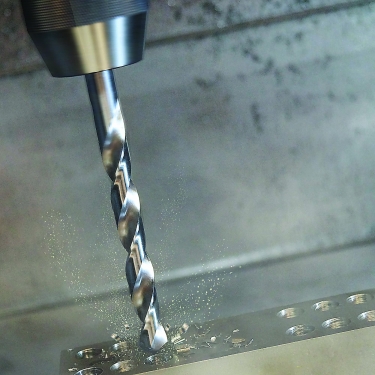HSS cutting tools are witnessing worldwide growth that shows no sign of slowing down. The increase is supported by steady demand from key segments, such as automotive and construction, as well as heavy electrical and industrial equipment.
Despite growing competition from solid carbide, HSS continues to be popular due to its high hardness and wear resistance at an affordable price. But its best feature is its toughness. HSS cutting tools are best-suited to job shop production environments where versatility and tool cost are most important. In these cases, the material plays a major part in the efficient, reliable machining of a variety of components. Product quality at a cost-effective price is proving attractive in the present global economic climate.

HSS continues to be popular at machine shops because of its toughness properties, as displayed by Precision Twist Drill’s R10P HSS drill with bright finish. Image courtesy of Dormer Pramet
To support growing worldwide demand for HSS, cutting tool manufacturers have committed extensive resources to this segment, including increased investment in R&D activities. These investments have led to HSS tools becoming more reliable, with improved quality, lower production costs and shorter lead times. The addition of improved substrates, including powder metallurgy and coatings, has been instrumental in further enhancing performance of HSS tools.
A typical HSS composition features chromium (4 percent), tungsten (6 percent), molybdenum (5 percent), vanadium (2 percent) and carbon (1 percent). The different grades depend on the varying levels of elements added. The result is a tool material with high toughness that isn’t likely to fracture or break.
A conventional HSS-E composition is slightly different due largely to the addition of cobalt (between 5 and 8 percent), an increase of molybdenum (up to 9 percent) and a decrease of tungsten (down to 1.5 percent). These differences give higher hot hardness and wear
resistance compared with HSS. Typically, tools made with the addition of more cobalt are for specific
applications.
HSS tools resist vibrations, whatever the type of machine tool, even if rigidity has been lost over time and regardless of workpiece clamping conditions. HSS prevents mechanical shocks at the tooth level when milling and copes with varying lubrication conditions that may result in thermal changes.
Also, thanks to the unique strength of HSS, tool manufacturers can produce extremely sharp cutting edges. This makes it easier to machine difficult-to-cut materials and reduces workhardening of austenitic stainless steels and nickel alloys.
With the proper cutting geometry, the workpiece material is sheared and not pushed, which extends tool life and reduces cutting-edge temperatures. The right geometry also lowers cutting forces, which ultimately means less power consumption from the machine tools.
From a tool life point of view, HSS performs very well with intermittent cutting applications. However, its limited cutting speed range is far lower compared with carbide tools. HSS-E and PM HSS substrates can be a good alternative for bridging the gap between HSS and carbide tools in terms of cutting speeds and
productivity.
HSS may be an established cutting tool material, but that does not mean that it has failed to be developed and improved since its first use in the late 19th century. The development of HSS-E grades with higher cobalt content and HSS-E with PM offers a higher content of alloy elements and a combination of unique properties that improve toughness, wear resistance and hardness. Using HSS-E-PM prolongs tool life, makes it more predictable, improves machining parameters and helps reduce chipping or fracture problems often experienced when using solid-carbide substrates.
Also, HSS-E and HSS-E-PM are excellent substrates for a variety of coatings, such as TiN, TiAlN and TiCN, as well as multilayer coatings.
Coatings considerably improve tool life. They further boost the performance of HSS tools in environments where productivity and speed and feed rates are high. This holds true when dry machining and when cutting challenging or hardened materials. Coatings offer increased surface hardness for higher crater wear resistance, reduced friction for better chip creation, less heat generation and improved surface quality. For example, TiAlN-coated HSS-E cutting tools are suitable for dry machining cast iron, as this helps resist high temperatures, whereas TiAlN-coated HSS-E-PM tools are suitable for machining medium-to-hard alloys.
In an age when users require reliable, consistent, versatile tools at a cost-effective price, HSS remains the ideal choice for many applications. As such, it can still hold its own in the marketplace against newer, more technically advanced materials. If anything, HSS has become stronger over many years by adapting with new coatings, adjusting its composition and adding technology, all helping to retain its position as a vital material in the metalcutting industry.
The cutting tool industry has always been a competitive landscape. HSS remains a key component that offers customers what has always been essential: choice.
—Gary Kirchoff and Jesus Nava, product managers at Dormer Pramet Inc., Elgin, Illinois
Related Glossary Terms
- alloys
alloys
Substances having metallic properties and being composed of two or more chemical elements of which at least one is a metal.
- cutting speed
cutting speed
Tangential velocity on the surface of the tool or workpiece at the cutting interface. The formula for cutting speed (sfm) is tool diameter 5 0.26 5 spindle speed (rpm). The formula for feed per tooth (fpt) is table feed (ipm)/number of flutes/spindle speed (rpm). The formula for spindle speed (rpm) is cutting speed (sfm) 5 3.82/tool diameter. The formula for table feed (ipm) is feed per tooth (ftp) 5 number of tool flutes 5 spindle speed (rpm).
- feed
feed
Rate of change of position of the tool as a whole, relative to the workpiece while cutting.
- gang cutting ( milling)
gang cutting ( milling)
Machining with several cutters mounted on a single arbor, generally for simultaneous cutting.
- hardness
hardness
Hardness is a measure of the resistance of a material to surface indentation or abrasion. There is no absolute scale for hardness. In order to express hardness quantitatively, each type of test has its own scale, which defines hardness. Indentation hardness obtained through static methods is measured by Brinell, Rockwell, Vickers and Knoop tests. Hardness without indentation is measured by a dynamic method, known as the Scleroscope test.
- high-speed steels ( HSS)
high-speed steels ( HSS)
Available in two major types: tungsten high-speed steels (designated by letter T having tungsten as the principal alloying element) and molybdenum high-speed steels (designated by letter M having molybdenum as the principal alloying element). The type T high-speed steels containing cobalt have higher wear resistance and greater red (hot) hardness, withstanding cutting temperature up to 1,100º F (590º C). The type T steels are used to fabricate metalcutting tools (milling cutters, drills, reamers and taps), woodworking tools, various types of punches and dies, ball and roller bearings. The type M steels are used for cutting tools and various types of dies.
- lapping compound( powder)
lapping compound( powder)
Light, abrasive material used for finishing a surface.
- metalcutting ( material cutting)
metalcutting ( material cutting)
Any machining process used to part metal or other material or give a workpiece a new configuration. Conventionally applies to machining operations in which a cutting tool mechanically removes material in the form of chips; applies to any process in which metal or material is removed to create new shapes. See metalforming.
- milling
milling
Machining operation in which metal or other material is removed by applying power to a rotating cutter. In vertical milling, the cutting tool is mounted vertically on the spindle. In horizontal milling, the cutting tool is mounted horizontally, either directly on the spindle or on an arbor. Horizontal milling is further broken down into conventional milling, where the cutter rotates opposite the direction of feed, or “up” into the workpiece; and climb milling, where the cutter rotates in the direction of feed, or “down” into the workpiece. Milling operations include plane or surface milling, endmilling, facemilling, angle milling, form milling and profiling.
- powder metallurgy
powder metallurgy
Processes in which metallic particles are fused under various combinations of heat and pressure to create solid metals.
- stainless steels
stainless steels
Stainless steels possess high strength, heat resistance, excellent workability and erosion resistance. Four general classes have been developed to cover a range of mechanical and physical properties for particular applications. The four classes are: the austenitic types of the chromium-nickel-manganese 200 series and the chromium-nickel 300 series; the martensitic types of the chromium, hardenable 400 series; the chromium, nonhardenable 400-series ferritic types; and the precipitation-hardening type of chromium-nickel alloys with additional elements that are hardenable by solution treating and aging.
- titanium aluminum nitride ( TiAlN)
titanium aluminum nitride ( TiAlN)
Often used as a tool coating. AlTiN indicates the aluminum content is greater than the titanium. See coated tools.
- titanium carbonitride ( TiCN)
titanium carbonitride ( TiCN)
Often used as a tool coating. See coated tools.
- titanium nitride ( TiN)
titanium nitride ( TiN)
Added to titanium-carbide tooling to permit machining of hard metals at high speeds. Also used as a tool coating. See coated tools.
- wear resistance
wear resistance
Ability of the tool to withstand stresses that cause it to wear during cutting; an attribute linked to alloy composition, base material, thermal conditions, type of tooling and operation and other variables.
- workhardening
workhardening
Tendency of all metals to become harder when they are machined or subjected to other stresses and strains. This trait is particularly pronounced in soft, low-carbon steel or alloys containing nickel and manganese—nonmagnetic stainless steel, high-manganese steel and the superalloys Inconel and Monel.

